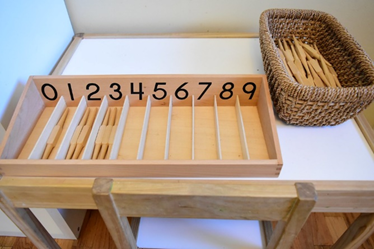9.2: Environmental Factors in Supporting Math
Young children actively construct mathematical knowledge through everyday interactions with their environment. Setting up a high-quality physical environment is essential for children’s mathematical development. The preschool environment sets the stage for children’s physical and social exploration and construction of mathematical concepts. It should provide access to objects and materials that encourage children to experiment and learn about key mathematical concepts through everyday play.
- Enrich the environment with developmentally appropriate, challenging, and engaging materials that promote mathematical growth
- Integrate math-related materials into all interest areas in the classroom
- Use materials, books, and real-life settings that reflect the culture, ways of life, and languages of the children in the group
- Use children’s books to explore mathematics with children
- Be intentional and mindful in setting up and using the physical environment (children do not effectively use materials and engage in experiences just because you provide them)[1]

Research Highlight
Research indicates that the ability to reason about numbers starts as early as infancy. Five-month-olds show sensitivity to the effects of addition or subtraction of items on a small collection of objects. Toddlers viewing three balls put into a container and then one being removed know to search for a smaller number of balls, and many search for exactly two balls.
By the time children are in preschool, prior to having any formal lesson in arithmetic, they use a variety of strategies to solve simple addition and subtraction problems. They may use manipulatives or fingers to represent the numbers in the problem and count out loud to find out the answer. As they get older, they rely less and less on finger counting. To solve an addition problem such as 4 + 2 presented with concrete objects (e.g., color crayons), the child may count all objects “one, two, three, four” and then continue with the second set of objects “five, six” and find out there are a total of six. At a later stage, the child may “count on” from the second set of objects. Knowing the number of objects in the first set (e.g., “four”), the child starts with “four” and continues to count “five, six” to find out the total number of objects, rather than starting to count from “one” with the second set of objects.[2]
Source:
K. Wynn, “Addition and Subtraction by Human Infants,” Nature 358 (1992): 749– 50.
P. Starkey, “The Early Development of Numerical Reasoning,” Cognition 43, no. 2 (1992): 93–126.
R. S. Siegler, “The Perils of Averaging Data Over Strategies: An Example from Children’s Addition,” Journal of Experimental Psychology: General 116, no. 3 (1987): 250–64.
- The California Preschool Learning Foundations, Volume 1 by the California Department of Education is used with permission ↵
- The California Preschool Learning Foundations, Volume 1 by the California Department of Education is used with permission ↵

